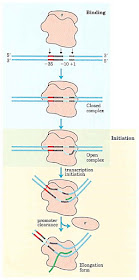Initiation:
Begins with the binding of DNA dependent RNAP holoenzyme to promoter in template DNA.
| Fig. TATA sequence (Source : Lehninger's Biochemistry, 4th Edition) |
Alpha subunit binds to UP element and sigma factor covers -35 to -10 region.
Binding of RNAP to -35 forms closed complex whereas to -10 region forms open complex, due to the presence of AT region which has low Tm and also these sites have low nucleosomal density.
Human as 105 initiation sites. RNAP first scans DNA at 103 bp/s until it finds (specially sigma factor) promoter sequences to which it binds firmly. Promoters are present in coding strand in 5’ to 3’ direction.
 |
| Fig. Initiation step (Source: Lehninger's Biochemistry, 4th Edition) |
Purine is the 1st nucleotide to be polymerized and exists at 5’ end of RNA as nucleotide
Elongation:
Progression occurs by local unwinding (melting) of the DNA. The elongation phase is said to begin when the transcript (typically starting with a purine) exceeds 10 nucleotides in length. Sigma is then released, and the core enzyme is able to leave the promoter and move along the template strand in a processive manner. During replication, a short DNA-RNA hybrid helix is formed which is subsequently released.
Termination:
E. coli has 2 class of termination sequence in template DNA. One class is recognized by termination protein "Rho" ,that's rho-dependent and other is rho independent.
a. Rho-independent.
Formation of RNA transcript with pallindromic sequence (self complementary) that form hairpin structure (GC rich) and another structure is conserved string of 3A residue in 3’ end of template strand.
 |
| Fig. Rho independent Termination (Source: Lehninger Biochemistry, 4th Edition) |
Rho protein associates with RNA at C-rich site near 3’ end and moves along the RNA until it reaches RNAP paused at termination site. The rho protein has ATP dependent RNA-DNA helicase activity that promotes release of RNA-DNA hybrid helix causing the release of RNA.
In eukaryotic cell after 3’ end of transcript is encoded, RNA endonuclease cleaves the primary transcript about 15 bases 3’ to consensus sequence AAUAAA that serves as cleavage signal.
Action of antibiotics:
- Rifampin (anti tuberculosis drug) - inhibits the initiation of transcription by binding to the β subunit of prokaryotic RNA polymerase, thus interfering with the formation of the first phosphodiester bond.
- Dactinomycin (Actinomycin D) – Anti cancer drug - It binds to the DNA template and interferes with the movement of RNA polymerase along the DNA.


No comments:
Post a Comment